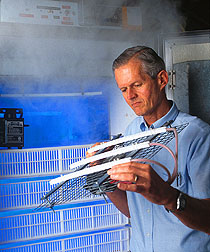This page has been archived and is being provided for reference purposes only. The page is no longer being updated, and therefore, links on the page may be invalid.
Dust-Reduction System To Be Licensed
By Sharon DurhamDecember 30, 2004
A Minnesota company will be granted an exclusive license by the Agricultural Research Service (ARS) to commercialize an electrostatic system for reducing dust in livestock housing.
Baumgartner Environics, Inc., of Olivia, Minn., will have an exclusive field-of-use license for the device, developed by ARS engineer Bailey Mitchell, based at the ARS Southeast Poultry Research Laboratory in Athens, Ga. The device was originally developed to reduce airborne dust and microorganisms in poultry houses and hatcheries.
The system uses an electrostatic charge to trap airborne particles and microbes, including Salmonella. Lab studies show that the system kills both airborne and surface Salmonella and other pathogenic bacteria. In one research study, the system killed at least 95 percent of airborne and surface S. enteritidis.
Additionally, the system reduces biofilms up to 99.8 percent when used at close range. Biofilms are formed by pathogenic bacteria that stick to surfaces and then cover themselves with a protective coating.
Lab studies also indicate the electrostatic charge keeps surface dust near its source. For example, loose dust on the floor of a treated room tends not to become airborne, because as soon as it leaves the floor it is charged and re-attracted to the floor.
Baumgartner Environics will initially use the device as a companion technology to its patented Bio-Curtain system. Used together, the two technologies will effectively reduce dust, ammonia and odors in air emissions from animal housing. The system is also expected to reduce airborne disease-causing microorganisms.
ARS is the U.S. Department of Agriculture's chief scientific research agency.


